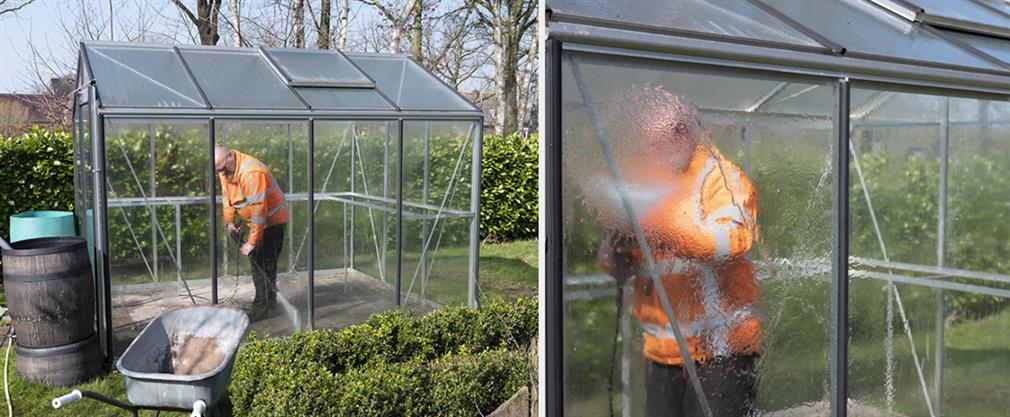Make your greenhouse ready for the new season

A greenhouse is a wonderful place where you can enjoy lots and lots of beautiful flowers, fruits and vegetables – not to mentioned how great it is just to be inside a warm greenhouse filled with lush plants. However, a greenhouse also requires a little work – during the season, of course, but especially when you start a new season. Here is what you should do before you start filling fresh soils into your pots, containers, beds and trays.
1. Start by emptying your greenhouse
If possible, empty the greenhouse completely so you have room to work. Wait for a day with fine weather so you have light to see what you are doing. If you have delicate flowers or plants that cannot be moved as they are growing in the ground, you have to do your best to get around these obstacles when you clean and making the greenhouse ready. You could cover the plants with a tarpaulin or similar so they do not get splashed with soapy water. If you have old withered plants, remove them and throw them on the compost. NB! If there has been pests or sickness, consider burning the remains as pests, diseases and viruses may survive inside the protected environment in the greenhouse even though it may have been cold during winter.
2. Be careful with the power
If you have power sockets inside the greenhouse, please turn off the power – or cover the sockets - before you start washing down as things can get a little wet when you wash down the windows and more.
3. Look for pests and more
Start by sweeping the floor and remove everything from the corners and more. Look for any signs of garden pests such as slugs and snails as they will often hibernate inside the greenhouse if possible.
4. Eco-friendly soap and disinfectant
Make a large bucket of hot, soapy water and wash down shelves, pots and planters. We recommend that you use an eco-friendly garden disinfectant for cleaning planters and other containers, but make sure you rinse them before you start filling fresh soil into them. Like old fashion dishwash, put the pots and more into the water, clean them thoroughly and remember to rinse everything with clean water at the end.
5. Clean the windows and more
Clean the windows as they can have all kinds of algae and mildew due to the warm environment inside the greenhouse. If there is too much growing on the windows, you can reduce the amount of light inside the greenhouse, which can deteriorate the growth conditions. Hence you can have troubles getting the best out of the plants. Again, use hot, soapy water and a brush to scrub the glass clean. You can have a brush for cleaning cars where you can attach the garden hose to the brush – it will work great for rinsing the windows after they have been cleaned with soap. Make sure that you clean all the cracks and crevices between panes of glass.
6. Sealing the windows
If there are too many cracks and crevices around the window panes, you may want to upgrade your greenhouse by adding silicone if you haven’t already. The silicone will tighten the greenhouse, fasten the window panes, keeping the panes from moving when it is windy and making it easier to clean the greenhouse in general.
7. Fresh soil
If you use planter boxes with sacks of potting soil, you buy new ones every year and you have no problems with pests and viruses from last year. However, if you have soil in beds and containers, it would be a good idea to at least partially replace the soil so the new plants have fresh soil without any deceases. During the growing season, always remove any dead leaves from the surface of the soil to prevent fungal infections taking hold. To make the most of your soil inside the greenhouse, use fertilizer when needed.
8. Check for damages
When cleaning your greenhouse to make it ready for the new season, check for any damages in the frame, windows and base. It is so much easier to repair things now before the greenhouse is filled with growing plants. Furthermore, keeping the greenhouse in top condition will make it last longer and provide the best growing conditions.
9. Broken window panes
If you see any cracked window panes, it is now you should change or repair. Cracked glass panes will allow heat to escape and water to seep in. You can repair a cracked window pane by adding weatherproof glass tape, but the best will be to replace the pane. Even though polycarbonate windows are stronger, we recommend that you keep the kind of materials you have to keep the greenhouse even and looking like it is supposed to from the manufacturer. So do not replace a glass window with a piece of polycarbonate even though it is easier to work with. Do you have glass windows in a wooden greenhouse? Make sure that all the windows are sealed tight with the right kind of window putty. Check that doors and windows open and close easily and apply a little light oil to hinges if necessary.
10. Check the window clips and more
Do you have a greenhouse where the windows are fastened with clips? Check all the clips and make sure they are in place. The clips can sometimes loose grip or get dislodged due to the movements of the frame caused by wind and change of temperature. Be careful if you use a high-pressure cleaner as the jet stream may cause harm to windows and more. In general, cleaning a greenhouse with polycarbonate windows is easy as you simply wipe down both the inside and outside with warm soapy water to remove any dirt and grime.
11. Check the nuts and bolts for rust
When you are cleaning your greenhouse, check the joints of the frame and the nuts and bolts. Is everything tight? If you detect rust, you may want to replace the corroded parts.
12. The base must be plane and stable
The base of the greenhouse is very important. If the base has sunk or cracked, you will have troubles very soon. The greenhouse may begin to tilt and doors and windows may be difficult to work properly. Worst case scenario is that the entire greenhouse will be damaged. Check the foundation or base of your greenhouse and repair or fix it, if you detect any problems. That is why it is important to make a solid base or foundation for your greenhouse when you start building it. Even though most greenhouses are made of lightweight materials, the total weight can cause problems if the base is not strong enough.
- Talk with an Expert 23 341 84 00
- Chat with an Expert
- Get a call from an Expert
- Buy now


























